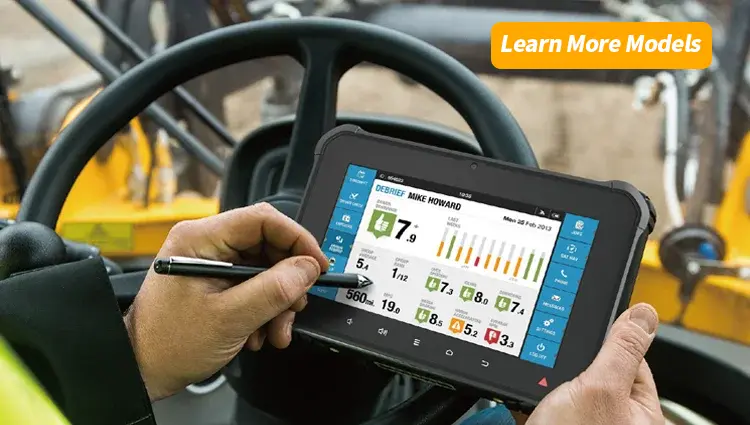Best Rugged Tablets of 2025: Top Picks for Tough Jobs
- 1. Durability Standards
- 2. Operating System
- 3. Performance
- 4. Display
- 5. Connectivity
- 6. Battery Life
- 7. Accessories and Customization
- What Is the Most Durable Rugged Tablet?
- Are Rugged Tablets Worth the Cost?
- Can Rugged Tablets Run Normal Apps?
- How Do Rugged Tablets Handle Outdoor Use?
- What’s the Difference Between Rugged and Semi-Rugged Tablets?
Rugged tablets are built to withstand tough conditions. They’re designed for professionals in industries like construction, logistics, healthcare, and field services. Unlike standard tablets, rugged tablets resist dust, water, drops, and extreme temperatures. If you’re searching for “rugged tablet” or related terms like “best rugged tablet for construction” or “rugged tablet with GPS,” this guide answers your questions. It provides in-depth insights, original content, and practical advice to help you choose the right device. Let’s dive into what makes rugged tablets unique and how to pick the best one for your needs.
What Are Rugged Tablets?
Rugged tablets are durable devices engineered for harsh environments. They meet strict standards like MIL-STD-810G for shock, vibration, and temperature resistance. Many also have IP65 or IP68 ratings, meaning they’re dustproof and water-resistant. These tablets are ideal for workers who need reliable technology outdoors or in demanding settings.
Unlike consumer tablets, rugged tablets prioritize durability over sleek design. They often feature reinforced frames, rubberized edges, and Gorilla Glass screens. Some include specialized features like barcode scanners, hot-swappable batteries, or 4G/5G connectivity for fieldwork. For example, a 2024 study by Statista reported that 68% of field service professionals prefer rugged devices for their reliability in extreme conditions.
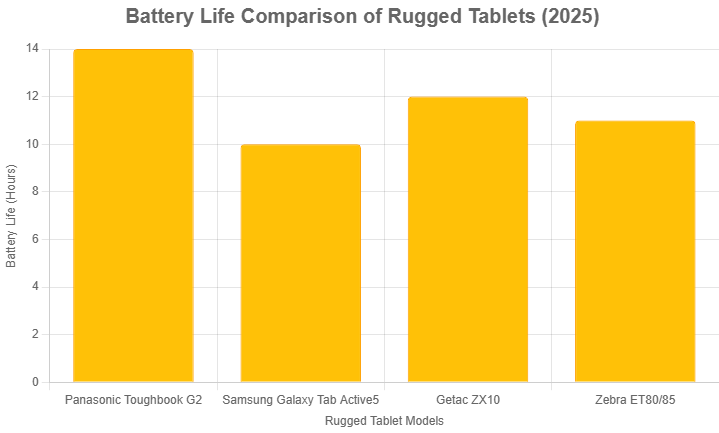
Why Choose a Rugged Tablet?
- Survives drops, spills, and extreme weather
- Supports specialized software for industries
- Offers long battery life for extended use
- Reduces downtime and repair costs
Who Needs a Rugged Tablet?
Rugged tablets serve professionals across various sectors. Construction workers use them to access blueprints on dusty sites. Logistics teams rely on them for inventory tracking in warehouses. Healthcare providers use rugged tablets to update patient records in sterile environments. Even outdoor enthusiasts, like hikers or geologists, benefit from their durability and GPS features.
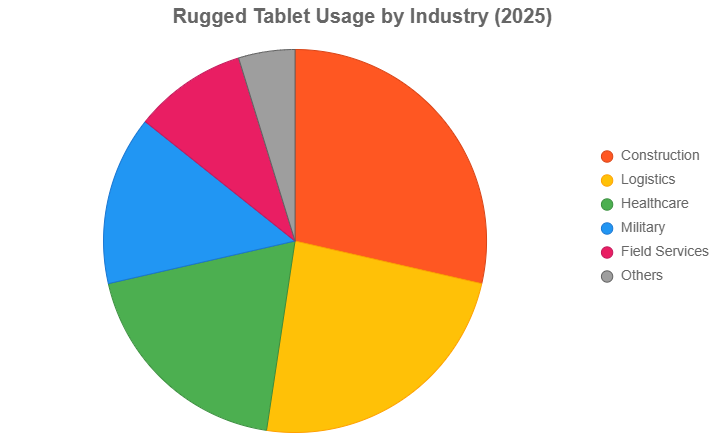
Key Industries Using Rugged Tablets:
- Construction: Access plans, track progress, and communicate in real-time.
- Logistics: Scan barcodes, manage shipments, and navigate routes.
- Healthcare: Record data, access medical apps, and ensure hygiene.
- Military: Operate in extreme conditions with secure communication.
- Field Services: Perform maintenance tasks with reliable connectivity.
If you’re searching for a rugged tablet, you likely work in one of these fields or face similar challenges. This guide ensures you find a device that matches your specific needs.
Why Rugged Tablets Outperform Standard Tablets
Standard tablets like iPads or Samsung Galaxy Tabs are great for casual use. However, they lack the durability needed for tough environments. A single drop or splash can render them useless. Rugged tablets, on the other hand, are built to last.
Key Advantages of Rugged Tablets:
- Durability: Survive drops from 4-6 feet and extreme temperatures (-20°C to 60°C).
- Water and Dust Resistance: IP68 ratings ensure protection against submersion and dust.
- Long Battery Life: Many models offer 10-14 hours of use, with some supporting hot-swappable batteries.
- Specialized Features: GPS, barcode scanners, and glove-touch screens enhance functionality.
- Cost Efficiency: Higher upfront cost but lower repair and replacement expenses.
A 2023 Gartner report found that businesses using rugged tablets reduced device failure rates by 40% compared to standard tablets. This reliability saves time and money in high-stakes environments.
How to Choose the Best Rugged Tablet
Selecting a rugged tablet requires understanding your specific needs. Here are the key factors to consider:
1. Durability Standards
Look for MIL-STD-810G or MIL-STD-810H certification. These standards confirm the tablet can handle drops, shocks, and extreme conditions. IP65 or IP68 ratings indicate water and dust resistance. For example, an IP68 tablet can survive submersion in 1.5 meters of water for 30 minutes.
2. Operating System
Choose between Windows, Android, or iOS. Windows is ideal for enterprise software like Microsoft Office. Android offers flexibility and app variety. iOS is less common but available in some rugged models, like the Apple iPad with rugged cases.
3. Performance
Consider processor speed, RAM, and storage. For heavy apps, opt for at least an Intel Core i5 or Qualcomm Snapdragon 8 series with 8GB RAM and 128GB storage. This ensures smooth performance for multitasking or data-intensive tasks.
4. Display
A bright, readable screen is crucial for outdoor use. Look for displays with 500+ nits brightness and anti-glare coating. Touchscreens should support glove or wet-finger use for practicality.
5. Connectivity
Ensure the tablet supports Wi-Fi, 4G/5G, and GPS. Bluetooth 5.0 and NFC are bonuses for connecting peripherals like scanners or keyboards.
6. Battery Life
Fieldwork demands long-lasting batteries. Choose models with 10+ hours of runtime. Hot-swappable batteries allow uninterrupted use by swapping without powering down.
7. Accessories and Customization
Many rugged tablets offer docks, vehicle mounts, or stylus pens. Check for compatibility with your workflow, like barcode scanners for logistics or docking stations for vehicles.
Pro Tip: Use tools like Panasonic’s Rugged Device Selector to match tablets to your industry needs.
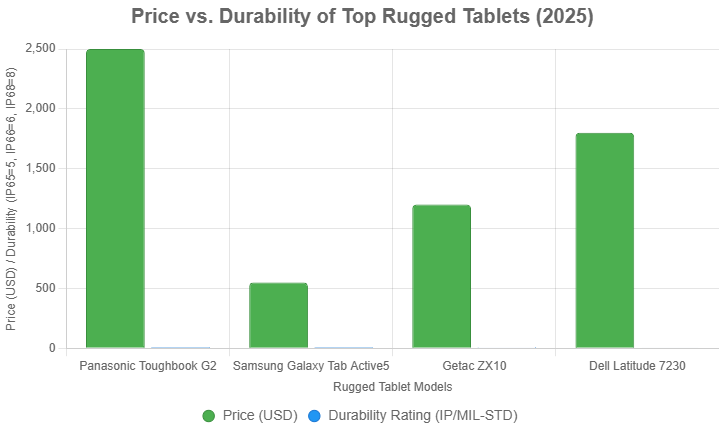
Top 10 Rugged Tablets for 2025
Here are the top rugged tablets based on performance, durability, and user reviews. These models excel for various use cases, from construction to healthcare.
- Panasonic Toughbook G2
- Specs: Intel Core i7, 16GB RAM, 512GB SSD, 10.1” display, IP65, MIL-STD-810H
- Best For: Construction, military, field services
- Why Choose?: Modular design with hot-swappable batteries and optional barcode scanner.
- Price: ~$2,500
- Source: Panasonic Toughbook
- Samsung Galaxy Tab Active5
- Specs: Exynos 1380, 6GB RAM, 128GB storage, 8” display, IP68, MIL-STD-810H
- Best For: Logistics, retail, outdoor enthusiasts
- Why Choose?: Affordable, lightweight, and includes S Pen for note-taking.
- Price: ~$550
- Source: Samsung Business
- Getac ZX10
- Specs: Qualcomm Snapdragon 480, 8GB RAM, 256GB storage, 10.1” display, IP66
- Best For: Field services, transportation
- Why Choose?: Bright 800-nit display and excellent GPS for navigation.
- Price: ~$1,200
- Dell Latitude 7230 Rugged Extreme
- Specs: Intel Core i5, 8GB RAM, 256GB SSD, 12” display, IP65, MIL-STD-810H
- Best For: Construction, emergency services
- Why Choose?: Lightweight design with powerful Windows performance.
- Price: ~$1,800
- Zebra ET80/85
- Specs: Intel Core i5, 8GB RAM, 128GB SSD, 12” display, IP65
- Best For: Logistics, warehousing
- Why Choose?: Built-in barcode scanner and robust enterprise software support.
- Price: ~$2,000
- Durabook R11
- Specs: Intel Core i7, 16GB RAM, 512GB SSD, 11.6” display, IP66
- Best For: Healthcare, manufacturing
- Why Choose?: Slim design with antimicrobial coating for medical use.
- Price: ~$1,600
- Lenovo ThinkPad X1 Tablet (Rugged Case)
- Specs: Intel Core i5, 8GB RAM, 256GB SSD, 13” display, IP65 (with case)
- Best For: Office-to-field transitions
- Why Choose?: Detachable keyboard for hybrid laptop use.
- Price: ~$1,500
- MobileDemand Flex 10B
- Specs: Intel Celeron, 4GB RAM, 128GB storage, 10.1” display, IP65
- Best For: Budget-conscious buyers
- Why Choose?: Affordable yet durable for small businesses.
- Price: ~$700
- Juniper Systems Mesa 3
- Specs: Intel Atom, 8GB RAM, 128GB storage, 7” display, IP68
- Best For: Geologists, outdoor research
- Why Choose?: Compact with precise GPS for fieldwork.
- Price: ~$1,300
- Xplore XSLATE R12
- Specs: Intel Core i7, 16GB RAM, 256GB SSD, 12.5” display, IP54
- Best For: Engineering, design
- Why Choose?: High-resolution display for detailed blueprints.
- Price: ~$2,200
Note: Prices are approximate and may vary by region or configuration. Check manufacturer websites for the latest deals.
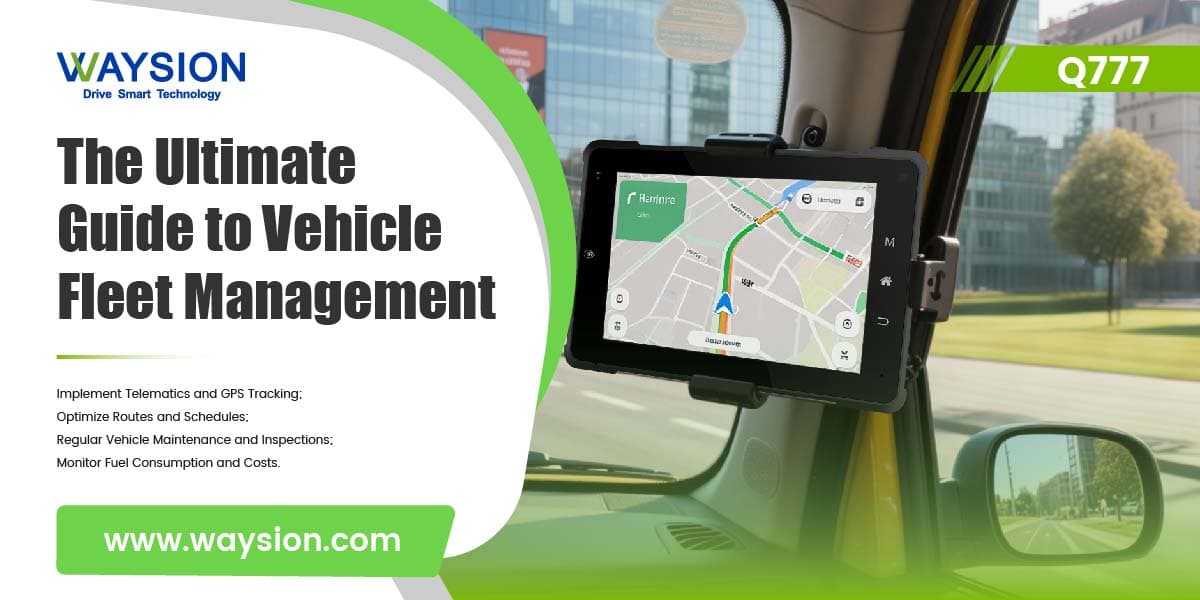
What Is the Most Durable Rugged Tablet?
The Panasonic Toughbook G2 is often cited as the most durable. It meets MIL-STD-810H and IP65 standards, surviving 6-foot drops and extreme temperatures. Its modular design allows customization for specific tasks, making it a top choice for harsh environments.
Are Rugged Tablets Worth the Cost?
Yes, for professionals in demanding fields. Rugged tablets reduce downtime and repair costs. A 2024 IDC study found that businesses using rugged devices saved 25% on maintenance compared to standard tablets. The higher upfront cost pays off in reliability and longevity.
Can Rugged Tablets Run Normal Apps?
Absolutely. Most rugged tablets run Windows or Android, supporting apps like Microsoft Office, Adobe Acrobat, or industry-specific software. Ensure the operating system matches your app requirements before purchasing.
How Do Rugged Tablets Handle Outdoor Use?
Rugged tablets excel outdoors. High-brightness displays (500-800 nits) ensure visibility in sunlight. IP68 ratings protect against rain and dust. Built-in GPS supports navigation, ideal for field services or outdoor research.
What’s the Difference Between Rugged and Semi-Rugged Tablets?
Rugged tablets meet strict MIL-STD-810G/H and IP65/68 standards, ideal for extreme conditions. Semi-rugged tablets offer partial protection (e.g., IP54) and are suited for less harsh environments, like indoor warehouses. Choose based on your exposure to dust, water, or drops.

Tips for Optimizing Rugged Tablet Performance
To get the most out of your rugged tablet, follow these practical tips:
- Update Software Regularly: Ensure the operating system and apps are up-to-date for security and performance.
- Use Protective Accessories: Invest in screen protectors, carrying cases, or vehicle mounts to extend device life.
- Calibrate GPS: For navigation-heavy tasks, calibrate GPS settings for accuracy.
- Manage Battery Health: Avoid overcharging and use power-saving modes to prolong battery life.
- Test in Real Conditions: Before deploying, test the tablet in your work environment to ensure it meets expectations.
Common Mistakes to Avoid When Buying a Rugged Tablet
Avoid these pitfalls to make an informed purchase:
- Ignoring Durability Ratings: Don’t assume all rugged tablets are equal. Check MIL-STD and IP ratings.
- Overlooking Compatibility: Ensure the tablet supports your software and peripherals.
- Focusing Only on Price: Cheaper models may lack critical features like GPS or long battery life.
- Skipping Reviews: Read user feedback to understand real-world performance.
Conclusion: Find Your Perfect Rugged Tablet
Rugged tablets are essential tools for professionals in tough environments. They offer unmatched durability, specialized features, and reliable performance. Whether you’re in construction, logistics, or healthcare, there’s a rugged tablet tailored to your needs. Use this guide to evaluate options, avoid common mistakes, and choose a device that boosts productivity.
Ready to invest in a rugged tablet? Start by identifying your industry’s needs, checking durability ratings, and comparing top models like the Panasonic Toughbook G2 or Samsung Galaxy Tab Active5.


